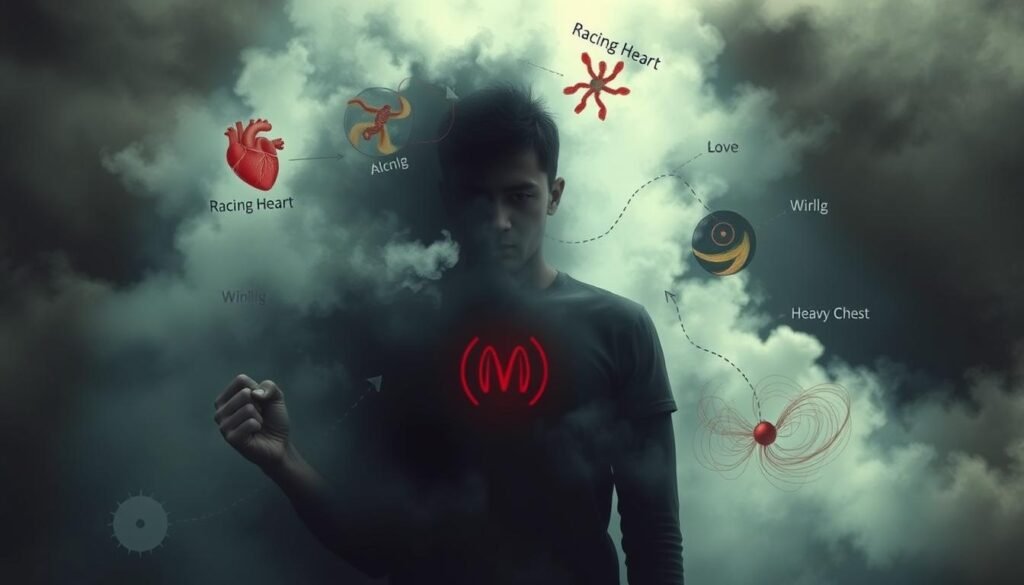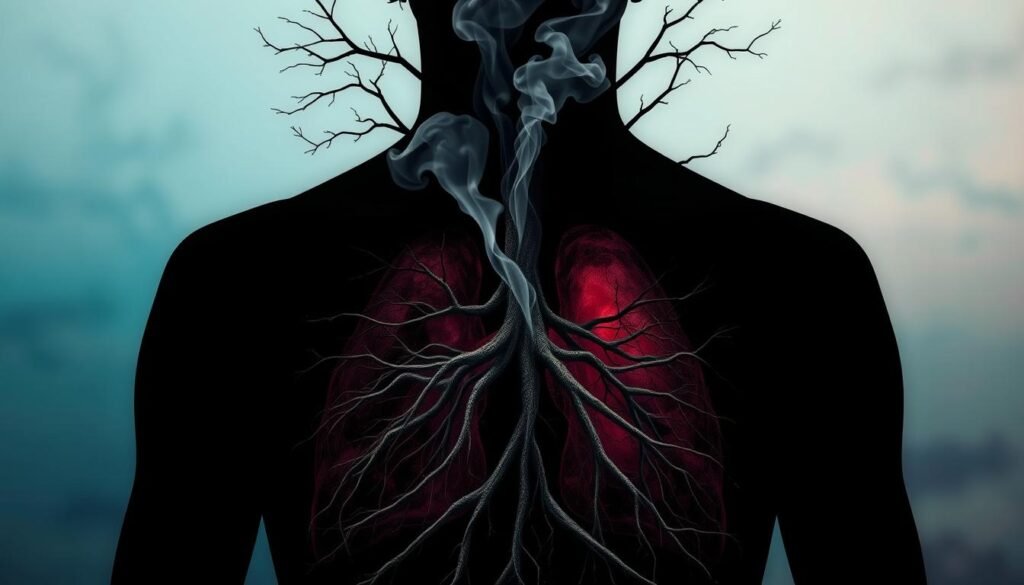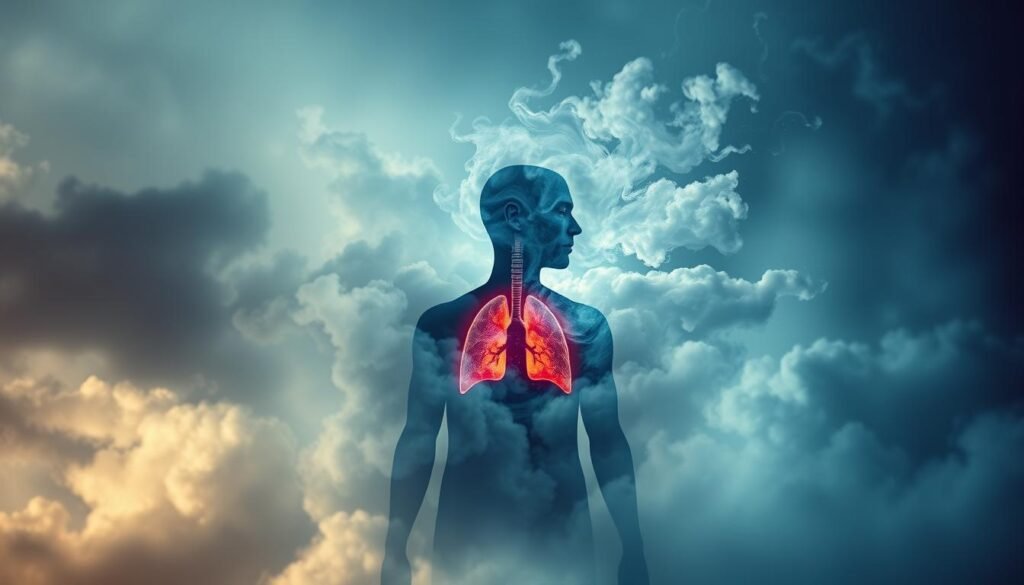Did you know nearly 40 million adults in the U.S. battle anxiety disorders? This makes it the top mental health issue. This large number shows how deeply anxiety affects not just our minds but our bodies too. Studies show a clear link between anxiety and health problems, especially with breathing issues. People with anxiety often breathe too fast and too shallow. This can make physical symptoms worse and lead to long-term sickness.
Anxiety doesn’t just touch the mind; it also sparks troubles in the body’s main systems. These include the heart, stomach, and lungs. To fight anxiety and its effects, we must understand how it connects to other health problems. Around 3% of U.S. adults have Generalized Anxiety Disorder (GAD). It’s more important than ever to dive into how anxiety works. This can help us get better at treating it. For deeper understanding on anxiety’s effects, visit this informative resource.
Key Takeaways
- Anxiety disorders are linked to various physical health issues, notably respiratory conditions.
- Common symptoms of anxiety include rapid and shallow breathing.
- Shortness of breath is frequently reported by individuals coping with anxiety.
- The interplay between anxiety and respiratory problems underscores the need for a holistic approach to mental and physical health.
- Effective management techniques, including breathing exercises and mindfulness practices, can alleviate anxiety-related symptoms.
- Professional treatment options for anxiety may include therapy and medication to reduce its impact on physical health.
Understanding Anxiety Disorders
Anxiety disorders include conditions like generalized anxiety disorder and panic disorder. They also cover social anxiety disorder and specific phobias. Each affects mental health and leads to psychological symptoms.
Generalized anxiety disorder means always worrying too much about daily things. This worry is often more than the situation warrants. It can cause physical health problems because of the constant stress.
Panic disorder causes sudden fear attacks that feel like disasters. These come with physical signs like breathing hard and chest pain.
Social anxiety disorder makes social events scary. People fear being embarrassed or judged. This fear can limit their life significantly. Specific phobias cause anxiety around certain things, sometimes leading to panic attacks.
Anxiety disorders might come with health issues like heart problems. Conditions such as diabetes and thyroid problems can also appear with anxiety disorders. This can make it harder to figure out the right treatment.
It’s crucial to identify these disorders for proper anxiety treatment. Trauma, ongoing stress, and genetics might cause them. Getting help early can stop worse problems like depression and lasting pain. Staying active and connecting with others helps ease anxiety symptoms.
Common Symptoms of Anxiety
The symptoms of anxiety show up in both body and mind, affecting someone’s mental health. Physical signs might be a fast heartbeat, feeling restless, and tight muscles. Mental effects often include too much worry and fear. Anxiety disorder symptoms can be very different for everyone. This makes it hard to know and deal with them.
People with anxiety disorders don’t all feel it the same way. Someone with generalized anxiety disorder may feel worried all the time, making daily life hard. Panic disorder leads to sudden moments of extreme fear, making people scared of another attack. Those with social anxiety disorder find being around people very stressful. And phobias cause strong fear of specific things or situations.

Conditions like OCD and PTSD share some anxiety-like symptoms. This can make it tricky to figure out the right diagnosis. Also, some physical health issues, like hormone or brain problems, might show anxiety signs. It’s important to know and understand these symptoms to manage and get help.
Knowing how anxiety and other health problems are connected can help people find the right support. Issues like stomach or heart troubles can look like anxiety too. Learning about the different anxiety disorder symptoms lets people understand their experiences better. It helps plan ways to face these challenges, as discussed in more depth here.
Potential Links to Anxiety, Respiratory Conditions, and Other Health Issues
Anxiety and health issues, especially respiratory problems, are deeply connected. This affects how well we feel. Panic attacks are a key example. They often cause breathing troubles and a sense of fear. By understanding these potential links to anxiety and breathing problems, we can better manage and treat them.
Panic Attacks and Their Symptoms
Panic attacks come on suddenly and are very scary. They can cause:
- Heart palpitations
- Shortness of breath
- Trembling or shaking
- Chest pain
- Dizziness or feeling faint
- Nausea or abdominal distress
People with breathing problems, like COPD, may find panic attacks especially hard. Those with COPD are more likely to have panic attacks, making their condition worse.
The Overlap with Respiratory Disorders
Anxiety raises the chance of panic attacks and is linked to lung disorders. Consider these statistics:
| Condition | Prevalence in COPD Patients | Relative Risk of Developing Health Issues |
|---|---|---|
| Depression | 10% to 57% | 1.69 compared to the general population |
| Anxiety | 7% to 50% | 1.27 for increased mortality risk |
| Severe Dyspnea | High correlation with depression | N/A |
Anxiety and respiratory problems are clearly linked, affecting many people’s lives. Panic attacks might highlight or worsen respiratory problems. So, tackling both issues could greatly improve health.

How Anxiety Affects Breathing
Anxiety changes how we breathe due to the body’s fight-or-flight response. When anxious, our bodies gear up for action, causing fast changes. These changes can hurt our breathing, leading to issues like shallow breaths.
The Fight-or-Flight Response
During anxiety attacks, the fight-or-flight response is activated. It floods the body with hormones to either face the threat or run away. This makes the heart beat fast and breathing quicken. Anxiety thus alters our normal breathing, making us feel overwhelmed.
Understanding Hyperventilation and Its Effects
People who are anxious often breathe fast and shallow, a condition called hyperventilation. This can disrupt the balance of oxygen and carbon dioxide in our blood. Symptoms like dizziness, shortness of breath, and confusion can occur. These symptoms make anxiety worse, trapping sufferers in a cycle of increasing distress.
Common Respiratory Problems Associated with Anxiety
Anxiety comes with many symptoms, one of which is common respiratory problems. People feeling anxious may have shortness of breath or hyperventilate when stressed. These breathing issues often make existing respiratory problems worse, causing more panic and distress.
There’s a link between anxiety and respiratory conditions like asthma and COPD. Anxiety makes these conditions worse, especially during stressful times. Sometimes, the respiratory symptoms in anxious people actually show their health problems getting worse, not just anxiety.
It’s key to know when respiratory symptoms are from anxiety or a real health issue. Smokers with anxiety tend to have worse breathing problems. They also try to quit more often, linking their anxiety-related respiratory issues to smoking. Keeping your lungs healthy with good food can lessen stress effects on breathing. For more tips on this, check out this helpful link.

Medical Conditions Related to Anxiety
Anxiety disorders entangle with other medical issues, making it hard to figure out and treat. People dealing with anxiety might see their symptoms look like those of other illnesses. Knowing how they connect is key to better health.
Chronic diseases can make anxiety worse. For instance, the pain and stress from endometriosis might be mistaken for anxiety. Diseases like PCOS can also cause mood changes and tiredness, which look a lot like anxiety.
- Inflammatory Bowel Disease (IBD): The ongoing inflammation from IBD can increase anxiety due to continuous stress and discomfort.
- Fibromyalgia: This condition often causes long-term pain and fatigue, making anxiety and depression symptoms worse.
- Adrenal Insufficiency: Conditions like Addison’s disease have symptoms like fatigue and low blood pressure, similar to anxiety.
- Postural Orthostatic Tachycardia Syndrome (POTS): POTS can cause feelings that are like panic attacks, including a fast heartbeat and dizziness.
- Lyme Disease: Lyme disease leads to tiredness and thinking problems, often mistaken for anxiety disorders.
- Ankylosing Spondylitis (AS): AS’s chronic pain can hide itself as symptoms of anxiety, making it hard to diagnose accurately.
- Hyperthyroidism: A fast heartbeat and feeling nervous from hyperthyroidism can seem like anxiety, mixing up the diagnosis.
- Inappropriate Sinus Tachycardia (IST): IST brings on symptoms that look a lot like anxiety and panic attacks, including a speedy heartbeat.
Generalized Anxiety Disorder (GAD) is widespread in the U.S., marked by ongoing worry. It can start in the young years or show up later. Stress from family or surroundings can set off its symptoms. These might also come from other health problems.
Knowing how anxiety and other medical conditions impact each other helps in getting complete care. It looks at mental and physical health together.
Environmental Factors and Their Impact on Health
Environmental factors greatly affect our health, especially air quality and breathing health. Around 3.6 billion people live where climate change poses big dangers, leading to more sickness. This change could cause about 250,000 extra deaths each year due to things like poor nutrition and lung infections from bad air.
Studies show that bad air full of tiny particles and ozone can make lung diseases like asthma and COPD worse. Being around this dirty air for a short time can send people to the hospital for lung problems and cause asthma attacks. If you’re exposed for a long time, your chance of dying from any cause increases by 6-8% for every slight rise in particulate matter.
“The link between air pollution and health is well known, highlighting the need for better air quality initiatives.”
Kids and old folks are especially at risk from bad air. For example, air pollution can cause lifelong anxiety and sadness in children. It harms more than our lungs; it can hurt our hearts and minds too. Climate and air quality changes are blamed for over 700,000 deaths from diseases carried by insects.
| Health Impact | Annual Deaths | Associated Condition |
|---|---|---|
| Cardiovascular diseases | Estimated 2 million | Long-term air pollution exposure |
| Respiratory diseases | Estimated 130,000 | Asthma and COPD |
| Heat-related conditions | 250,000 (projected by WHO) | Climate change effects |
| Psychiatric disorders | 73% of exposed populations reported symptoms | Air pollution exposure |
Understanding how environmental factors affect air and lung health is key. This knowledge helps us create plans to reduce these issues. It’s vital to act and spread awareness to keep people safe, especially the most vulnerable.
To learn more, check out this research article on how the environment affects our breathing health.
Preventing Anxiety-Related Respiratory Issues
Anxiety can really affect your breathing and make existing health issues worse. It’s important to handle this by learning special breathing skills and how to manage stress better. Doing this doesn’t just lower anxiety. It also makes you feel better overall.
Breathing Exercises and Techniques
Breathing right is a key way to fight anxiety. It helps you breathe better and feel calmer. Studies show that slowing down your breath and getting proper guidance works best. Here are a few good ways to breathe:
- Diaphragmatic Breathing: Take a deep breath through your nose, let your belly go up, and breathe out slowly through your mouth.
- Box Breathing: Breathe in for four counts, hold it, breathe out for four, and hold again.
- 4-7-8 Method: Breathe in for four seconds, hold for seven, then breathe out for eight seconds to relax.
Stress Management Practices
Using good stress management can also ease breathing problems caused by anxiety. Methods like being mindful, doing yoga, and undergoing cognitive-behavioral therapy help balance your emotions. This supports your breathing health. Adding these methods to your everyday life helps keep anxiety under control. Here are a few strategies:
- Mindfulness Meditation: Stay in the moment, accept your feelings without judging them.
- Yoga: Use body poses, mindfulness, and deep breaths to relax and lessen anxiety.
- Cognitive-Behavioral Therapy: Change negative beliefs and behaviors with structured help.
| Technique | Benefits |
|---|---|
| Breathing Exercises | Improves how your lungs work, lowers signs of anxiety |
| Mindfulness Meditation | Better control of emotions, less stress |
| Yoga | Boosts overall health and calmness |
| Cognitive-Behavioral Therapy | Deals with anxiety roots, promotes healthier thinking |
Conclusion
The link between anxiety and breathing problems is important for both mental and physical health. Many people with anxiety face physical symptoms that make lung problems worse. This includes diseases like COPD and asthma. Studies show that up to half of all COPD patients may also have anxiety. It’s clear that noticing these issues early and responding well is key to helping patients.
It’s crucial to look at health as a whole, considering both mind and body. Helping with anxiety can make breathing easier and help manage long-term illnesses better. This shows how tailored health care plans are needed. As mental health gets more focus, those with anxiety or breathing issues should get professional advice.
Doctors who understand the link between anxiety and lung problems can create better care plans. Increasing awareness of this connection can improve life quality for many. It helps those dealing with these tough health challenges.